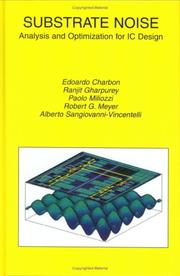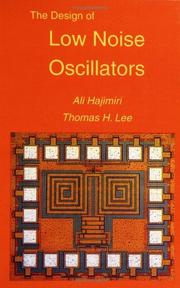| Listing 1 - 2 of 2 |
Sort by
|

ISBN: 9780792373254 0792373251 9780306481710 0306481715 Year: 2003 Publisher: New York, New York : Kluwer Academic Publishers,
Abstract | Keywords | Export | Availability | Bookmark
 Loading...
Loading...Choose an application
- Reference Manager
- EndNote
- RefWorks (Direct export to RefWorks)
In the past decade, substrate noise has had a constant and significant impact on the design of analog and mixed-signal integrated circuits. Only recently, with advances in chip miniaturization and innovative circuit design, has substrate noise begun to plague fully digital circuits as well. To combat the effects of substrate noise, heavily over-designed structures are generally adopted, thus seriously limiting the advantages of innovative technologies. Substrate Noise: Analysis and Optimization for IC Design addresses the main problems posed by substrate noise from both an IC and a CAD designer perspective. The effects of substrate noise on performance in digital, analog, and mixed-signal circuits are presented, along with the mechanisms underlying noise generation, injection, and transport. Popular solutions to the substrate noise problem and the trade-offs often debated by designers are extensively discussed. Non-traditional approaches as well as semi-automated techniques to combat substrate noise are also addressed. Substrate Noise: Analysis and Optimization for IC Design will be of interest to researchers and professionals interested in signal integrity, as well as to mixed signal and RF designers.
Integrated circuits --- Electronic circuits --- Circuits intégrés --- Circuits électroniques --- Design and construction. --- Noise. --- Conception et construction --- Bruit --- -Integrated circuits --- Electron-tube circuits --- Electric circuits --- Electron tubes --- Electronics --- Noise --- Computer aided design. --- Computer engineering. --- Electronic circuits - Noise. --- Engineering. --- Integrated circuits. --- Systems engineering. --- Electrical & Computer Engineering --- Engineering & Applied Sciences --- Electrical Engineering --- Design and construction --- Computer-aided engineering. --- Electrical engineering. --- Electronic circuits. --- Circuits and Systems. --- Electrical Engineering. --- Computer-Aided Engineering (CAD, CAE) and Design. --- Noisy circuits --- CAE --- Engineering --- Electric engineering --- Data processing

ISBN: 0792384555 0306481995 9780792384557 Year: 2003 Publisher: New York : Kluwer Academic Publishers,
Abstract | Keywords | Export | Availability | Bookmark
 Loading...
Loading...Choose an application
- Reference Manager
- EndNote
- RefWorks (Direct export to RefWorks)
It is hardly a revelation to note that wireless and mobile communications have grown tremendously during the last few years. This growth has placed stringent requi- ments on channel spacing and, by implication, on the phase noise of oscillators. C- pounding the challenge has been a recent drive toward implementations of transceivers in CMOS, whose inferior 1/f noise performance has usually been thought to disqualify it from use in all but the lowest-performance oscillators. Low noise oscillators are also highly desired in the digital world, of course. The c- tinued drive toward higher clock frequencies translates into a demand for ev- decreasing jitter. Clearly, there is a need for a deep understanding of the fundamental mechanisms g- erning the process by which device, substrate, and supply noise turn into jitter and phase noise. Existing models generally offer only qualitative insights, however, and it has not always been clear why they are not quantitatively correct.
Oscillators, Electric --- Electronic circuits --- Electronic noise --- Radio frequency oscillators --- Oscillateurs --- Circuits électroniques --- Bruit électronique --- Oscillateurs haute fréquence --- Design and construction --- Noise --- Conception et construction --- Bruit --- -Electronic noise --- -Radio frequency oscillators --- RF oscillators --- Electric oscillators --- Electric apparatus and appliances --- Electric machinery --- Radio --- Noise, Electronic --- Signal theory (Telecommunication) --- Electric noise --- Electron-tube circuits --- Electric circuits --- Electron tubes --- Electronics --- Computer engineering. --- Design and construction. --- Electronic circuits. --- Electronic noise. --- Engineering. --- Noise. --- Oscillators, Electric. --- Oscillators. --- Electrical & Computer Engineering --- Engineering & Applied Sciences --- Electrical Engineering --- Radio frequency oscillators. --- Circuits électroniques --- Bruit électronique --- Oscillateurs haute fréquence --- EPUB-LIV-FT SPRINGER-B --- Electrical engineering. --- Circuits and Systems. --- Electrical Engineering. --- Systems engineering. --- Noisy circuits --- Electric engineering --- Engineering --- Oscillators, Electric - Design and construction --- Electronic circuits - Noise
| Listing 1 - 2 of 2 |
Sort by
|

 Search
Search Feedback
Feedback About UniCat
About UniCat  Help
Help News
News